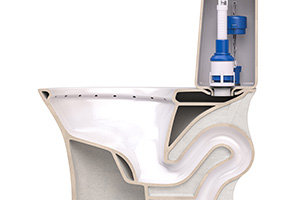 When dealing with below-ground plumbing systems, such as in a basement bathroom, you may have encountered the term ejector pump. But what exactly does it do, and how does it work? In this blog, we’ll break down the functionality of ejector pumps, their role in plumbing systems, and why they are crucial for efficient wastewater management in your home.
When dealing with below-ground plumbing systems, such as in a basement bathroom, you may have encountered the term ejector pump. But what exactly does it do, and how does it work? In this blog, we’ll break down the functionality of ejector pumps, their role in plumbing systems, and why they are crucial for efficient wastewater management in your home.
What Is an Ejector Pump?
An ejector pump, also known as a sewage ejector pump, is a mechanical device that removes wastewater and solid waste from below-ground areas like basements. Since gravity alone cannot transport waste upward to the main sewer line, ejector pumps provide the necessary lift, pushing waste up and out to the home’s main drainage system.
Key Components of an Ejector Pump
To understand how ejector pumps work, it’s helpful to know their main components:
- Pump Basin: A sealed container that collects wastewater and solid waste from your basement bathroom or laundry room.
- Pump Motor: The motor powers the pump, pushing waste out of the basin.
- Discharge Pipe: This pipe carries the waste from the basin to the main sewer or septic system.
- Check Valve: Prevents backflow of waste into the basin.
- Vent Pipe: Ensures proper airflow to prevent pressure build-up and manage odors.
How Do Ejector Pumps Work?
Here’s a step-by-step breakdown of how ejector pumps operate:
1. Wastewater Collection
When you flush a toilet, take a shower, or run water in a basement sink, the wastewater flows into the pump basin. The basin is typically installed below the basement floor and is designed to hold both liquids and solid waste.
2. Float Switch Activation
Inside the pump basin is a float switch that monitors the water level. When the water and waste level rise to a certain point, the float switch activates the ejector pump.
3. Wastewater Removal
The pump motor kicks into action, creating pressure to push the wastewater up through the discharge pipe. This pipe connects to your home’s main sewer line or septic system, allowing waste to exit the house.
4. Check Valve Operation
As the pump removes wastewater, the check valve prevents any of it from flowing back into the basin. This ensures that waste moves in only one direction—up and out of the home.
5. Pump Deactivation
Once the water level in the basin drops back to a safe level, the float switch deactivates the pump. The system is now ready for the next cycle.
Common Applications for Ejector Pumps
Ejector pumps are essential in various plumbing scenarios:
- Basement Bathrooms: Toilets, sinks, and showers in below-grade bathrooms require ejector pumps to move waste upward.
- Laundry Rooms: If your washing machine is in the basement, the pump helps remove soapy wastewater.
- Basement Kitchens: Sink water is also removed efficiently using an ejector pump.
Ejector Pump Maintenance Tips
To ensure your ejector pump runs smoothly, follow these maintenance tips:
- Inspect the Float Switch: Check that the float switch isn’t stuck or malfunctioning, as this can cause the pump to fail.
- Clean the Basin: Over time, debris can accumulate in the basin. Periodic cleaning prevents clogs and odors.
- Avoid Flushing Non-Biodegradable Items: Items like wipes, diapers, or feminine products can damage the pump.
- Schedule Professional Maintenance: Have a plumber inspect your ejector pump annually to catch any potential issues early.
Troubleshooting Common Ejector Pump Problems
Here are some common issues homeowners experience with ejector pumps and tips to resolve them:
- Pump Won’t Turn On: Check the float switch and electrical connections.
- Frequent Cycling: This could indicate a problem with the check valve or float switch.
- Bad Odors: Clean the basin and ensure the vent pipe is clear to eliminate odors.
If problems persist, consult a licensed plumber for repairs or replacements.
Conclusion
Ejector pumps play a vital role in homes with below-ground plumbing systems, ensuring that wastewater and solid waste are transported efficiently to the main sewer line. By understanding how they work, you can better maintain your pump and avoid costly repairs.
Whether you’re installing a new ejector pump or troubleshooting an existing one, this guide provides the insights you need to keep your plumbing system running smoothly. If you’re unsure about any aspect of your pump, contact us!